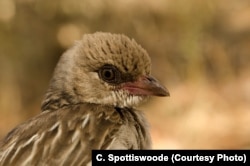Instances of collaboration between humans and wild animals are rare. One of the most noteworthy is that of the greater honeyguide bird, found in Africa, which seeks out humans and solicits their help to get a free meal.
New research published in Science magazine now shows that this intriguing indicator ("indicator" is the genus of honeyguide birds) also responds to human requests for help in finding beehives. The study reveals a mutually beneficial partnership for two very different species.
Follow the bird
The Yao people in Mozambique harvest honey using traditional techniques that have been passed down for generations. Hunters head out into the bush in search of bee hives, but they do not set out alone. They always call a friend: the greater honeyguide.
Honeyguides eat beeswax but are not especially good at obtaining it, since bees tend to react strongly to intruders who enter their hives. Previous studies with other African tribes found that honeyguides seek out humans to help them.
The birds produce a unique call to alert hunters they have found a beehive. Then they flit from tree to tree, leading their human companions to the hive, where they patiently await their reward.
The Yao dispatch the bees using smoke and chop down the tree holding the hive, so they can retrieve the sought-after honeycomb. Once the honey is extracted, the beeswax goes to the honeyguides, along with many of the stunned bees.
Bloodthirsty 'brood parasites'
Although honeyguides appear to cooperate with humans, their relationship with other avian species is quite different. Honeyguides are "brood parasites," meaning they rely on other birds to hatch their young.
Honeyguide nestlings hatch with hook-shaped beaks, which they use with deadly effectiveness to guarantee their survival in a crowded nest.
The newly hatched honeyguides use their hooked beaks to toss other chicks, the original occupants of the nest, to the ground below. They also puncture their host's eggs and kill her nestlings with repeated slashes of their beaks.
There is nothing mutually beneficial about that relationship.
But the honeyguides’ relationship with human bee hunters is what intrigues Claire Spottiswoode, an evolutionary biologist at the University of Cambridge in Britain and the University of Cape Town in South Africa. She wanted to know if these birds were actually responding to hunters’ calls for guidance. Or were they just seeking out humans independently to enlist help in their quest for beeswax?
Spottiswoode played three different sounds that might be of interest to honeyguides: a person saying words associated with honey hunting, regional dove calls and the Yaos' actual “brrrrr-hm” call.
“Our experiments showed that it really works,” Spottiswoode told VOA. “Giving the [Yao] sound doubled the chances of being guided by a honeyguide, and tripled the overall chances of actually finding a bees nest. Honeyguides really are paying attention to signals that humans communicate back at them.”
Unique relationship
Human and wild bird interactions are commonplace. Many people own bird feeders, or go bird watching. Geoff LeBaron, director of the Christmas Bird Count program for the National Audubon Society, notes that many birds will recognize the human responsible for filling the feeder.
Bird watchers and counters also use a method called pishing to attract birds. This involves making a "psh psh psh" noise to arouse birds' curiosity. But neither of these examples is the same as what happens between honey hunters and honeyguides, LeBaron told VOA.
Spottiswoode’s study clearly shows that the honeyguides only respond to Yaos calling out to them when they know a beehive is nearby. The bird has learned that the Yao call means these particular humans are looking for honey, and if the bird leads the humans to the hive, the two-legged hunters drive off or subdue the bees that guard the honeyguides’ prize.
“So they’ve got the humans well trained is really what it is,” chuckles LeBaron. “It’s a very mutualistic and learned behavior on both the people and the birds’ part.”
Tanzanians whistle to draw birds
Mozambique's Yao are not the only humans the honeyguides have contact with. Tanzania's Hadza people call out to honeyguides using a melodic whistle. Although both groups call on their feathered friends to help them find beehives, that is where the relationship similarities end.
Spottiswoode notes that the Yao present their guides with a “beeswax salad,” laying cleaned honeycombs on a bed of leaves for the birds to enjoy. The Hadza, on the other hand, hide or destroy the honeycombs they gather, hoping the birds that guided them, still hungry for beeswax, will lead them to another hive.
“The relationship thus involves elements of both mutualism and manipulation,” Brian Woods, a professor of anthropology at Yale University who studies the Hadza’s relationship with the honeyguides, told VOA by email. But that unique relationship is becoming more difficult to study.
A dying practice
Honey hunting is in trouble because store-bought honey and sugar is so easily available. Birds and human hunters cooperate only in places where human residents coexist with wild animals. Mozambique's Niassa National Reserve has provided a protected area where the Yao and honeyguides can hunt together without interruptions from the modern world.
The difference in regional honey-hunter practices raises an intriguing possibility, Spottiswoode says: "There might be a mosaic of honeyguide cultural variations across Africa that reflects that of their human partners. It would be really wonderful to understand this part of our own ecology and evolution before it’s too late.”
For now, the honeyguide will continue to work alongside the Yao, hopping through the trees to show them the honey so the birds can enjoy a beeswax salad.








